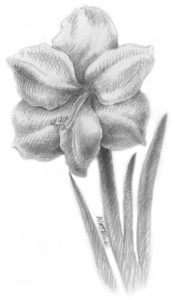October, Thinking Ahead With Ornamental Bulbs
By Leslie Watkins
Planting flower bulbs in the fall is like giving yourself a surprise present in the spring. Winter lasts just long enough to make it easy to forget exactly what and where you’ve planted. Squirrels and chipmunks add to the suspense by moving things around. No matter where the bulbs end up, their green shoots are a welcome sight. Sometimes a late snowstorm will blanket the emerging plants, but that won’t hold them back. It’s heartening to see tender Snowdrops, natives of Northern Europe, bravely weathering the snow and ice to grace us with their pristine beauty.

Amaryllis, by Leslie Watkins © 2018.
Ogier Ghiselin de Busbecq, ambassador of the Holy Roman Emperor Ferdinand I to the court of Sultan Suleiman the Magnificent, ruler of the Ottoman Empire, was a keen gardener. Constantinople, now known as Istanbul, was at the crossroads of the East and West. Settled between the 13th and 11th centuries BC, it had by the mid-16th century become the capitol of the Ottoman Empire. Second in size to the largest city in the world then, Beijing, China, Constantinople flourished. Suleiman’s reign fostered an age of great architectural and artistic achievements, including calligraphy and ceramics. Traders brought exquisite treasures from the East and gardens were everywhere. Palaces were adorned with tulips from Central Asia, signifying the wealth and power within. Busbecq sent tulips to botanist Carolus Clusius at the Viennese Imperial Gardens. Years later in the Netherlands, Clusius founded the Hortus Academicus, where flowers began to be grown for ornamental value rather than medicinal use. Tulips stolen from Clusius’ private collection started the Dutch bulb industry. Over the centuries Dutch growers have developed and hybridized bulbs into a vast selection of forms and colors. Billions of bulbs ship form Holland each year to destinations around the world. Grown on, the fresh cut flowers are then sold to florists.
Bulbs are perfectly suited for traveling long distances while in dormancy. Well-travelled bulbs originate from the corners of the earth; Daffodils from Spain, Amaryllis from South America, Freesias and Callas from South Africa, and Lilies from China. All can be delivered to your doorstep in time for planting. Bulbs are mini storage units that save the previous year’s energy for future growth. Allow the leaves to fully wither to ensure sufficient time for photosynthesis. Many bulbs will naturalize, readily making them especially attractive to less than enthusiastic gardeners. The initial investment of good soil preparation and thoughtful planting will bring increasing rewards for years to come. Select a sunny, well drained site to prevent rot. Slopes where the snow melts first are ideal. Early bulbs will also do well under deciduous trees before they leaf out. Rule of thumb is to plant bulbs three times as deep as their size.
,Amaryllis are festive plants that can decorate your home during the holidays. The name comes from the Greek, amarysso, meaning “to sparkle”. To force Amaryllis, plant the bulbs in late October or early November. It takes about eight weeks until bloom time. Chose a pot two inches bigger than the bulb, with drainage. Plant a “prepared” bulb (one that has been pre-chilled) in potting mix so that the top half is exposed. Water well and add a bamboo stake for support. Keep barely moist in a cool place. When it begins to grow move it to a sunny, warm spot and continue watering. Turn the pot to encourage the stalk to grow straight. It will bloom for several weeks. Afterwards, remove the yellowed flower stalk before it forms seeds. Place the plant by your sunniest window until it’s warm enough to go outside. Put it in partial shade, gradually moving it into full sun in summer, feeding regularly. In late summer, stop feeding and watering to bring on dormancy. Before frost bring your Amaryllis into a cool place until it’s time to start again.
Animal-Resistant Bulbs
- Alliums
- Camassia
- Chionodoxa
- Colchicum
- Galanthus
- Hyacinthoides hispanica
- Leucojum
- Muscari
- Narcissus
- Scilla Siberica
